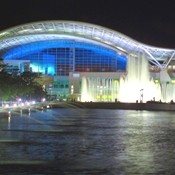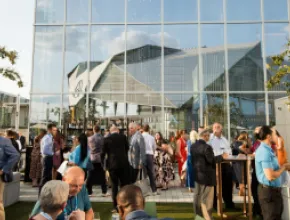Not so long ago, it was pretty hard to tell one big-box convention center from another. Nowadays, while they may not be as distinctive as the Eiffel Tower or the Golden Gate Bridge, many new and renovated convention centers have evolved into architectural icons that celebrate their surroundings, not shut them out.
Beyond their good looks, new and redesigned convention centers are adapting to market demand with hotel-quality ballrooms, abundant breakout space, theaters, intimate conference spaces, and indoor/outdoor function areas that rival many off-site venues.
“If the airport is the front door of the city, the convention center is becoming its living room,” says David O’Neal, chairman of Conventional Wisdom, an Orlando, Fla.,-based convention center development consulting firm. “The building has become a key element of the destination. There’s a real sense of place.”
O’Neal also notes that not only are convention centers getting better design elements, they are getting better real estate. “At one time, convention centers were built in blighted or outlying locations in hopes that they would encourage other development,” he says. “Now convention centers are being built in prime areas and on prime sites near hotels and attractions. They are part of an overall downtown package that makes the destination competitive.”
John Kaatz, vice president of CSL International, a Minneapolis-based convention center consulting firm, agrees, adding that many cities have been upgrading the amenities within walking distance of their centers.
“More often, you can walk out of the center and there is dining and entertainment right at hand,” he says. “San Diego and Denver have already done a good job on this, while Kansas City is a good example of a city that is developing a new entertainment district over six or seven blocks right around the convention center.”
Another place to watch will be the area surrounding New York City’s Jacob K. Javits Convention Center, which is slated to complete a long-awaited major expansion in 2010.
“Blocks around the convention center are being master-planned, and you’re going to see new hotels and restaurants opening up,” Kaatz says. “In five to seven years, the area around Javits will be transformed into one of the most interesting parts of New York.”
Kansas City Updated
A $135 million renovation and expansion of the Kansas City Convention Center is just one aspect of a major transformation of the city’s downtown convention center district set to be unveiled this fall. When the first phase of the Power & Light District is completed in October, convention delegates will be able to easily explore a nine-block area of eclectic boutiques, galleries, bookstores, and restaurants.
Another major enhancement will be the 18,500-seat Sprint Center, an arena accommodating major concerts, special events and large convention general sessions. The facility will also house the National Collegiate Basketball Hall of Fame.
As for the convention center itself, the building will feature a new 46,450-square-foot ballroom with 35,000 square feet of prefunction space and state-of-the-art technology. Water-themed design elements for the new ballroom will pay tribute to Kansas City’s fountains and its founding on the nexus of the Kansas and Missouri rivers.
Also on the agenda for the district is the $300 million Kauffman Center for the Performing Arts, which is scheduled to open just south of the convention center in 2009. The center will host performances of the Kansas City Symphony, Kansas City Ballet and other arts organizations.
Springing to Life
A prime example of centers that give a sense of their environment is the Palm Springs Convention Center, which completed a $32 million renovation and expansion in late 2005. In redesigning the facility, not only were Native American- and desert-inspired architectural details added, but the building was re-oriented to have its entrance face downtown and the surrounding mountains.
“The idea was to give more of a feeling of being part of the community,” says Rick Leson, director of sales for the convention center, adding that feedback about the changes has been positive. “The aesthetics are important to attendees. They don’t want to be plopped down in a box. We give them sweeping views of the mountains in the prefunction areas. When you take a break from the meeting, you want to see where you are.”
With a new 20,000-square-foot ballroom that sports a ceiling designed to give the impression of a storm rolling into the desert, special event possibilities have really opened up. “We’re doing Hollywood theme parties, Midnight at the Oasis parties,” Leson says. “We can light the ceiling a deep blue with a moon and stars or go with sunset colors.”
Cincinnati Style
A major expansion and renovation of Cincinnati’s Duke Energy Center, completed last summer, has also brought a transformation in form and function to a convention center.
“Our goal was to give people a sense of the city and to be an integral part of the city,” says Barrie Parks, vice president of sales and services for the Greater Cincinnati CVB. “We even incorporated part of an historic theater into the facade of the building, so some of Cincinnati’s history is part of the center.”
The redesign also include a dramatic three-story glass atrium framing the city skyline, a concourse evoking the Ohio River with a mural painted in watercolors, and a 40,000-square-foot ballroom enveloped in sheer gold, copper and bronze mesh fabric that cascades from the ceiling and down the walls.
With the eye-catching new ballroom, Parks says the Duke Energy Center is better able to serve high-end corporate meetings and events.
“Convention centers are going for the ‘wow’ factor these days, and it really makes a difference in bookings,” he says. “For instance, the NAACP is meeting here in summer 2008, which is business we won over Las Vegas. They came out for a site inspection and that did it.”
A Capital Idea
Even in a city renowned for its monuments, the Washington Convention Center, which opened in 2003, cuts an impressive figure. However, developing a convention facility in the nation’s capital posed numerous challenges, starting with finding a site.
After no less than 16 sites were considered, the decision was made to build the center among the brick row houses of the historic Shaw neighborhood. According to Reba Pittman Walker, general manager of the center, the major challenge was to design a building that would complement, not overwhelm, the low-rise neighborhood.
“We’re not a megastructure or a big, flat building, but actually three connected structures that cross above two streets,” she says. “Traffic flow in the neighborhood is not inhibited by the center. There’s a sense that we’ve been here all the time.”
A focal point of the center is the dramatic 72-foot Shaw Wall, which celebrates the neighborhood with works by local artists. Other elements include a soaring, light-filled Grand Lobby, an elegant ballroom suitable for inaugural galas and prefunction space with views of the Washington Monument and the Capitol Dome.
According to Pittman, the design of the center has a direct impact on the success of the events held there. “We host a lot of medical and educational meetings,” she says. “Because our environment is inspiring, it is conducive to education and stimulation. There is a sense of purpose.”
Puerto Rico
Also strong on regional design and ambience is the Puerto Rico Convention Center, which opened in late 2005 as the centerpiece of the Puerto Rico Convention Center District, a waterfront area with a park-like landscape of lagoons and fountains that is being developed with cafes, retail shopping, condos, and office space. A 500-room headquarters hotel is scheduled to open in 2009.
The 580,000-square-foot convention center features a dramatic wave-shaped roof and a spacious outdoor function area with views extending from Old San Juan to the beaches of the Condado hotel and tourist district. The interior of the building, which includes a 13-story glass wall and a 39,5000-square-foot ballroom with a massive chandelier inspired by wave images, features colors and architectural details reminiscent of Old San Juan’s historic buildings.
“The idea was to build something that really reflects the environment of Puerto Rico and the Caribbean,” says Mike Ezell, principal with TVS International, the Atlanta-based architectural firm that designed the convention center. “It’s a place conducive for business, but it’s also in keeping with a resort destination.”
Tulsa’s Vision
For Tulsa, Okla., the current challenge is to take a traditional 1960s-style convention center and make it appealing to 21st century meetings. When a $45 million renovation under way is completed in September 2008, the Tulsa Convention Center will feature a new 34,800-square-foot ballroom and 14 new breakout rooms along with an entirely new exterior and glass entry designed by Cesar Pelli, the architect of such edifices as the Petronas Towers in Kuala Lumpur.
Pelli, who also designed a new arena for Tulsa located across the street from the convention center, created a facade for center of stainless steel and glass that will harmonize with the arena.
According to Suzann Stewart, executive director of the Tulsa CVB, these changes will enable Tulsa to improve both the quality and quantity of its meetings business.
“The convention center served us well until the late 1990s and then we started to lose market share,” she says. “We knew we had to do something spectacular to gain it back. The market is asking for first-class meeting space, nice ballrooms, great amenities. Our goal is to increase our corporate business and we think this will help us realize this.”







